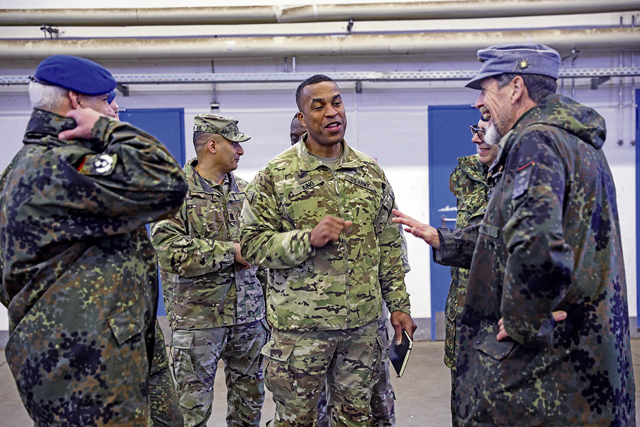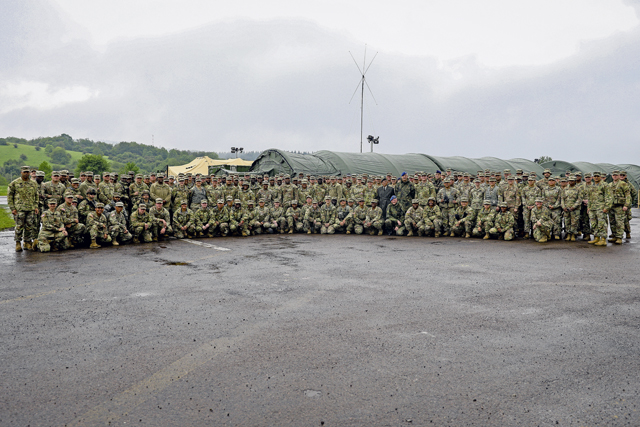
30th Medical Brigade, 21st Theater Sustainment Command in collaboration with the 810th Hospital Center, 75th Field Hospital, 7455th Medical Operations Unit and Medical Readiness Training Command successfully completed the final testing portion of the hospital exercise utilizing a 32-bed field hospital issued from an Army Prepositioned Stocks site in Germany for the first time in Europe, from April 29 – May 26, enhancing the readiness and capabilities of NATO medical capabilities.
As many historical firsts have taken place during Defender 2024 in the high north with newly established NATO allies, Finland and Sweden, right here within Germany the 30th MED BDE., 21st TSC makes Army medicine history with their Army Reserve partners utilizing a field hospital and all of its components completely from Army Prepositioned Stocks.
“We were able to draw from our Reserve Soldiers from all over the Southeast region of the U.S.,” said Col. Saul Weinreb, commander, 810th HC. “Mostly from Alabama and Georgia, but we have a contingent from Topeka, Kansas. All of us gathered together, we flew here to Germany, had an advanced team come and pull the stocks from APS, and in about 60 hours we have everything you see in front of you set up and ready to see, receive, and treat patients.”

Weinreb is not only the leader of his hospital center, but is an obstetrician gynecologist by trade within his home city of Birmingham, Alabama. Just a few weeks ago he was performing his day job like the rest of the citizen Soldiers in his unit, and now he is here conducting realistic medical training with European allies and partners. Not only did his unit leave their jobs to conduct this training all the way in Europe, but the team did it with other units they’ve never trained or operated with, constructing a field hospital to standard using equipment that’s not their own, in only two and a half days.
According to Col. Ross Witters, deputy chief surgeon, United States Army Europe and Africa, the impact of this exercise is not just about this being a medical first, but the collaboration of different medical units training together for the first time utilizing a field hospital with equipment that they are not used to utilizing on a regular basis.
“The U.S. Army has been providing health care and Army medicine for more than 200 years,” said Witters. “Setting up a hospital isn’t really the new part. The new part is the speed, rapidity, and projection. The fact that this hospital was pulled off the shelf, and we unwrap it and set it up, with a conglomerate of medical professionals in different terrain and with systems and personnel we haven’t trained with is powerful. The idea is having the ability to project that power from thousands of miles from where we all live and put it anywhere and have a hospital within three days. That’s what makes this unique.”
Everything within the hospital exercise was organized to simulate realistic scenarios involving the treatment of injuries, conducting surgeries and providing critical care to patients. Additionally, the exercise included the practice of patient transportation and evacuation using military medical evacuation capabilities. A lot of the training is done repetitively to create muscle memory to ensure if called upon the joint medical staff is ready to deal with patients in any scenario, whether it is during conflict or a humanitarian crisis.
“Having been a battalion surgeon and a brigade surgeon I will tell you combat training is vital,” said Witters. “We constantly train for war with the hopes we never have to go to war. But, when you do have to go to war, if you have not trained and built that muscle memory and know how to respond in a crisis, you’re going to be caught flat-footed. Training helps us develop muscle memory, experience, and readiness to identify where we need to improve or learn the capabilities we need to succeed on the battlefield.”
30th Medical Brigade, alongside their partners and Allies, have been in charge of medical planning and sustainment for a myriad of medical training and real-world operations in this theater as high north as Norway and as far south to the African continent in the country of Ghana. The team put emphasis on just how important medical readiness is within this ever-changing theater, throughout the entire exercise.
Maj. Gen. Ronald Ragin, commanding general, 21st TSC, decided to bring that emphasis a bit closer to home, with the realities of certain current events and lessons learned from what the world is witnessing on the battlefield during the Ukraine conflict.
“In Ukraine they’re having to[distribute medical]care more at the point of need,” said Ragin. “Even your evacuation assets are being targeted. Shelters like this out in the open[isn’t survivable]. If you can be found it can be targeted. We have to ensure this is concealed and survivable. We’ve got to think through those things.”
Ragin, who has served with the Security Assistance Group – Ukraine, consistently informs the medics and sustainers within the erected field hospital that we should all be learning from the operations and lessons we’re learning from the conflict in Ukraine, which is how to operate in a contested environment. Additionally, the senior logistician felt we were in great hands with the young Soldiers and Non-Commissioned Officers conducting operations together for the first time, as that will be the reality in a crisis situation, but we also must understand we can’t operate without our Allies, partners and Army Reserve Soldiers.
“We don’t do anything without our coalition partners, and we don’t do anything without our Reserve,” said Ragin. “For the U.S. military most of our medical assets, approximately 68 percent, I believe is in the COMPO 3[Army Reserve]. The specialty care that you give, I’m super proud of you. Those young Soldiers that were briefing me, junior enlisted Soldiers, those E-3’s and E-4’s on the complexity of what you do are truly amazing.”
DEFENDER is a Dynamic Employment of Forces to Europe for NATO Deterrence and Enhanced Readiness, and is a U.S. European Command scheduled, U.S. Army Europe and Africa conducted exercise that consists of Saber Strike, Immediate Response, and Swift Response. DEFENDER 24 is linked to NATO’s Steadfast Defender exercise, and DOD’s Large Scale Global Exercise, taking place from 28 March to 31 May. DEFENDER 24 is the largest U.S. Army exercise in Europe and includes more than 17,000 U.S. and 23,000 multinational service members from more than 20 Allied and partner nations, including Croatia, Czechia, Denmark, Estonia, Finland, France, Germany, Georgia, Hungary, Italy, Latvia, Lithuania, Moldova, Netherlands, North Macedonia, Norway, Poland, Romania, Slovakia, Spain, Sweden, and the United Kingdom.


